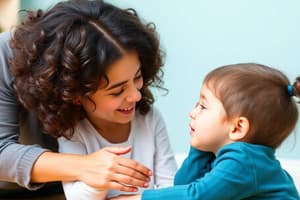Podcast
Questions and Answers
What is the primary difference between acquiring a language and learning one?
What is the primary difference between acquiring a language and learning one?
- Learning a language requires innate ability.
- Learning a language is subconscious.
- Acquisition allows intuitive use of language. (correct)
- Acquiring a language involves formal instruction.
How is overextension typically demonstrated in a child's vocabulary?
How is overextension typically demonstrated in a child's vocabulary?
- Understanding complex grammatical rules.
- Using a single word for multiple objects. (correct)
- Using many words for a single object.
- Limiting vocabulary to fewer common words.
What does cultural transmission primarily involve?
What does cultural transmission primarily involve?
- The conscious teaching of attitudes and beliefs. (correct)
- The genetic inheritance of behavior.
- The cultural adaptation to genetic predispositions.
- The subconscious learning of social norms.
Why might a child say 'dog' when referring to various four-legged animals?
Why might a child say 'dog' when referring to various four-legged animals?
What aspect of language acquisition is emphasized for native speakers?
What aspect of language acquisition is emphasized for native speakers?
What is meant by the term 'active experimenter' in language acquisition?
What is meant by the term 'active experimenter' in language acquisition?
Which of the following best describes caregiver speech?
Which of the following best describes caregiver speech?
At what age does the cooing stage of language acquisition typically begin?
At what age does the cooing stage of language acquisition typically begin?
What is indicative of the holophrastic stage in language acquisition?
What is indicative of the holophrastic stage in language acquisition?
Which statement correctly describes the telegraphic speech stage?
Which statement correctly describes the telegraphic speech stage?
What is a primary requirement for effective language acquisition in the first few years of life?
What is a primary requirement for effective language acquisition in the first few years of life?
At what age do children typically start to string together two-word combinations?
At what age do children typically start to string together two-word combinations?
Why is cultural transmission considered crucial in language acquisition?
Why is cultural transmission considered crucial in language acquisition?
Flashcards
Cultural Transmission
Cultural Transmission
The process of passing on cultural elements like attitudes, values, beliefs, and behaviors to individuals and groups.
Language Acquisition
Language Acquisition
The unconscious, intuitive process of acquiring language through natural exposure, like how a child learns their native tongue.
Language Learning
Language Learning
The conscious and deliberate process of learning a language through instruction and study.
Overextension
Overextension
Signup and view all the flashcards
Intuitive Language Use
Intuitive Language Use
Signup and view all the flashcards
Caregiver Speech
Caregiver Speech
Signup and view all the flashcards
Active Experimenter
Active Experimenter
Signup and view all the flashcards
Holophrastic Stage
Holophrastic Stage
Signup and view all the flashcards
Two-Word Stage
Two-Word Stage
Signup and view all the flashcards
Telegraphic Speech
Telegraphic Speech
Signup and view all the flashcards
Physical Capability
Physical Capability
Signup and view all the flashcards
Interaction & Exposure
Interaction & Exposure
Signup and view all the flashcards
Study Notes
Language Acquisition
- Children are "active experimenters" in language acquisition. They don't just repeat what adults say; they experiment with language structure to create sentences and discover correct conclusions.
Caregiver Speech
- Caregiver speech is a specialized speech style used by adults with infants and young children.
- It's characterized by short simple sentences, simplified grammar.
- It contains obvious questions the caregiver already knows the answers to.
- It uses a limited vocabulary.
- Speech is slow and repetitive.
- Example: "Where's Teddy? Oh look - there's teddy. He's on the chair."
Stages of Language Acquisition
- Cooing (4 months): Single vowel sounds like "ooh" and "aah".
- Babbling (6-10 months): Consonant-vowel or vowel-consonant sounds like "ma", "da", "um". Often interpreted as early communication attempts by parents.
- Holophrastic Stage (12-18 months): Simple words used to communicate needs. ("Juice" might mean "I want juice").
- Two-Word Stage (18-20 months): Two-word combinations to express simple thoughts and needs. ("Mommy up," "More juice").
- Telegraphic Speech (2-2.5 years): Simple sentences with essential words and correct word order, but missing grammatical elements. ("This shoe wet").
Basic Requirements for Language Acquisition
- Interaction with other language users.
- Exposure to the language.
- Physical ability to receive and produce sounds.
Cultural Transmission
- Cultural transmission is a vital process for language acquisition.
- It involves passing attitudes, values, beliefs, and behavioral scripts to individuals and groups. Language is acquired within a specific language-using environment, not inherited genetically.
Acquisition vs. Learning
- Acquisition: Intuitive, subconscious use of language with less focus on grammatical rules. Native speakers use this process.
- Learning: Conscious understanding of the language structure, allowing comprehension and use of complex language.
Overextension
- Overextension is when a child uses a single word to refer to multiple objects or concepts.
- Example: Using "dog" for all four-legged animals, "daddy" for all men, or "apple" for any round object.
Studying That Suits You
Use AI to generate personalized quizzes and flashcards to suit your learning preferences.




